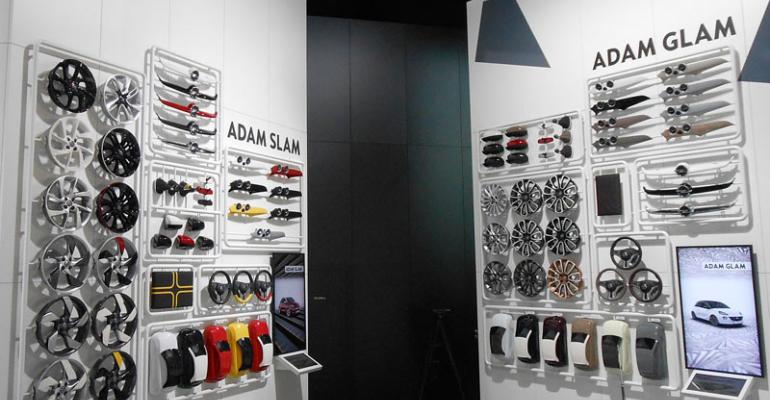PARIS – Adam Opel is looking to the new Opel Adam for a new lease on life.
Adam Opel has been in trouble with parent General Motors for years because of its losses, and the auto maker was nearly sold to a supplier during GM’s bankruptcy restructuring. It may still be in trouble, despite public assurances from leaders.
But Opel workers are confident they make good cars. Both the Insignia and Astra were well received when launched, but they are in highly competitive segments and being battered by price competition.
What Opel needed was something new that would increase volumes and attract new customers. The search for a solution began almost in secret in the summer of 2009, says Jean-Philippe Kempf, manager-brand communications for Europe.
“It went really fast, starting with a commando team with a will-do spirit,” Kempf says. “You need that kind of spirit when you want to do something daring.”
The Adam is daring because it is trying an idea that has failed twice in Europe: extreme personalization.
It is a small car, like a Fiat 500, but it can be personalized in so many ways that few will look alike. There are 31 different wheels available, in sizes from 15 to 18 ins. There are 12 basic body colors painted as 2-tones, which multiplies the possibilities. A 3-tone is possible for some sporty cars, with a special grille.
It is aimed at youth with Interlink, a €300 ($390) optional screen that connects to a smartphone and can bring most of its information into the car.
The standard headliner can be changed to show a cloudy summer sky in daylight or ambient star-scape at night. The instrument panel can match the body color or feature a back-lit material in various patterns. Different-colored spoke covers, seating materials and even steering wheels are available. Many of the trim elements can be changed during the course of ownership.
History is not kind to the idea. The original Smart Fortwo offered changeable body panels, and the Peugeot 1007 offers a menu of interior trim elements, but the idea hasn’t found widespread acceptance.
But, says Kempf: “People are now ready to individualize. Make many things affordable is the key.”
The Adam starts with a base price of €13,400 ($17,300), and the many optional items on the cars displayed at last month’s Paris auto show raised prices to between €17,600-€21,400 ($22,700-$27,600).
Former GM Europe chief Nick Reilly said in an earlier interview that the car is for people seeking “features like the latest infotainment (and) very good fuel economy, so they feel good about driving in the car and are willing to pay a bit more.”
The idea could work in Europe, where customers tend to order the car they want rather than buy one off a dealer’s lot, as is the norm in America. And models like the Citroen DS3, Mini and Fiat 500 are selling people on the idea of personalizing their cars by adding decals.
Kempf says a configuration program on the Internet will be critical to the Adam’s success, because it will give buyers control over all the possibilities.
“We help guide people with some packs,” collections of options that go together, he says. The Internet page will let people design their car from the base upward, from a completed model downward or by starting with a “most popular” format.
The Adam’s developers started the project in secrecy because they believed management would have trouble understanding and approving it when it was only an idea or PowerPoint presentation, Kempf says. By presenting the decision-makers with a design with a business case attached, it was easier to understand and accept.
Even the business case has an improvised history behind it. Young blue-collar workers at the Eisenach, Germany, plant claimed several years ago that the paint shop was more flexible than management thought. They said they could paint 2-tone cars, and they won approval for a run of 1,000 black-and-white models that sold within a few days.
After that experience, Kempf says, everyone attached to the project started thinking about how flexibility could be used to gain a competitive advantage.
The Adam will be built alongside the Corsa at Eisenach, which has annual capacity of 180,000 units. Opel has set an annual production goal of 100,000. The auto maker has invested €190 million ($245.2 million) in preparing the plant for Adam production, including €15.5 million ($20 million) provided by the regional government.
Three gasoline engines are offered: a 1.2L making 70 hp; a 1.4L making 87 hp; and a 1.4L producing 100 hp, all with a 5-speed manual transmission and able to be paired with stop/start. Top speed is 185 km/h (115 mph). The 3-door hatch is compact at 145.7 in. (370 cm) long and 67.7 in. (172 cm) wide.
Kempf says Italy is expected to be the biggest market for the Adam, followed by France and Germany. Deliveries are to start in January in Germany, followed by other European markets.





